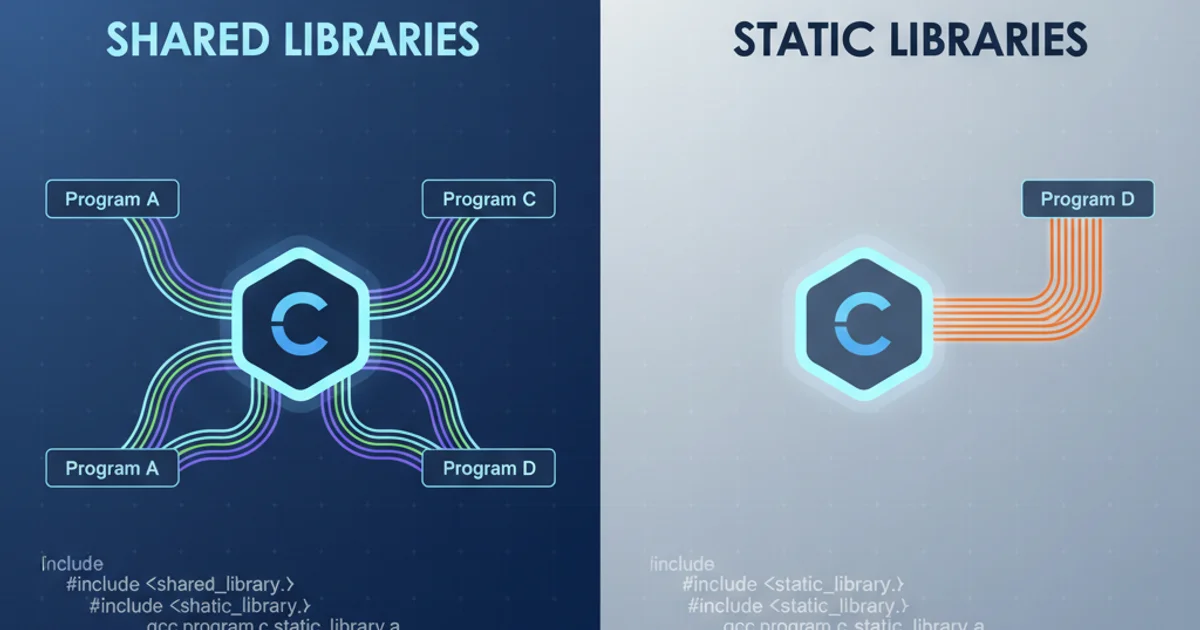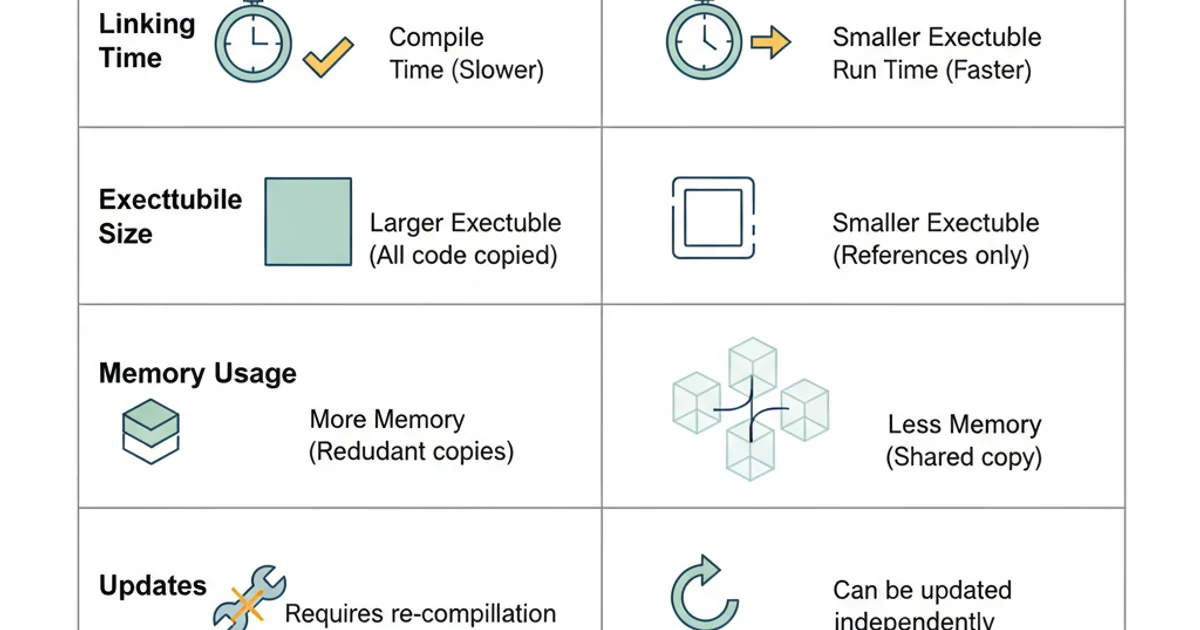What is the difference between shared and dynamic libraries in C?
Categories:
Shared vs. Dynamic Libraries in C: Understanding the Core Differences

Explore the fundamental distinctions between shared and dynamic libraries in C programming, their advantages, disadvantages, and how they impact application performance and deployment.
In C programming, libraries are collections of pre-compiled code that can be reused across multiple programs. They abstract away complex implementations, allowing developers to focus on application logic. When it comes to linking these libraries with your executable, two primary types emerge: shared libraries (often referred to as dynamic libraries) and static libraries. While both serve the purpose of code reuse, their mechanisms for linking, loading, and execution differ significantly, impacting application size, performance, and maintainability. This article delves into these differences, providing a clear understanding of when and why to choose one over the other.
Static Libraries: Early Binding and Self-Contained Executables
A static library (with a .a extension on Unix-like systems or .lib on Windows) is essentially an archive of object files. During the compilation process, the linker extracts all necessary code from the static library and embeds it directly into the final executable. This process is known as static linking or early binding because all library code is resolved and included at compile time.
flowchart TD
A[Source Code (.c)] --> B[Compiler]
B --> C[Object Files (.o)]
C --> D[Static Linker]
subgraph Static Library (.a)
E[Library Object 1 (.o)]
F[Library Object 2 (.o)]
end
D -- Includes all necessary code --> E
D -- Includes all necessary code --> F
D --> G[Executable (Self-contained)]Static Linking Process: Library code is embedded directly into the executable.
Dynamic/Shared Libraries: Late Binding and Runtime Resolution
Dynamic libraries (often .so on Unix-like systems or .dll on Windows) are not linked into the executable until runtime. Instead, the executable contains only references to the functions it needs from the dynamic library. When the program starts, the operating system's dynamic linker/loader finds the required dynamic libraries, loads them into memory, and resolves the function calls. This process is called dynamic linking or late binding.
flowchart TD
A[Source Code (.c)] --> B[Compiler]
B --> C[Object Files (.o)]
C --> D[Dynamic Linker (Compile-time)]
D -- Creates references --> E[Executable (Smaller)]
E -- At Runtime --> F[Dynamic Loader (OS)]
subgraph Dynamic Library (.so/.dll)
G[Library Code]
end
F -- Loads and links --> G
F --> H[Running Program]Dynamic Linking Process: Library code is loaded and linked at runtime.
Key Differences and Considerations
The choice between static and dynamic libraries involves trade-offs in several areas:

Comparison of Static vs. Dynamic Libraries
Executable Size
- Static: Larger executables because all library code is embedded.
- Dynamic: Smaller executables as they only contain references to libraries.
Memory Usage
- Static: Each process using the same static library will have its own copy of the library code in memory.
- Dynamic: Multiple processes can share a single copy of a dynamic library in memory, leading to more efficient memory usage.
Updates and Maintenance
- Static: To update a static library, you must recompile and redistribute every application that uses it.
- Dynamic: Updating a dynamic library only requires replacing the library file itself. All applications using it will automatically benefit from the update without recompilation, provided the API remains compatible.
Dependencies
- Static: No external runtime dependencies on library files, making deployment simpler.
- Dynamic: Requires the library files to be present on the target system at runtime. This can lead to 'DLL Hell' on Windows or 'shared object not found' issues on Linux if dependencies are not managed correctly.
Performance
- Static: Slightly faster startup time as all code is already part of the executable. Function calls are direct.
- Dynamic: Slightly slower startup due to the overhead of the dynamic linker/loader resolving symbols at runtime. Function calls might involve an extra indirection layer (Procedure Linkage Table).
Compilation Example
Let's illustrate with a simple C example. Suppose we have a mymath.h and mymath.c for a simple addition function.
// mymath.h
#ifndef MYMATH_H
#define MYMATH_H
int add(int a, int b);
#endif // MYMATH_H
// mymath.c
#include "mymath.h"
int add(int a, int b) {
return a + b;
}
// main.c
#include <stdio.h>
#include "mymath.h"
int main() {
int result = add(5, 3);
printf("Result: %d\n", result);
return 0;
}
Compiling and Linking Examples
Here's how you would compile and link these files using both static and dynamic approaches on a Unix-like system (using GCC).
Static Library
Compile mymath.c into an object file
gcc -c mymath.c -o mymath.o
Create a static library from the object file
ar rcs libmymath.a mymath.o
Compile main.c and link with the static library
gcc main.c -L. -lmymath -o static_app
Run the application
./static_app
Dynamic Library
Compile mymath.c into a position-independent code (PIC) object file
gcc -c -fPIC mymath.c -o mymath.o
Create a dynamic library from the object file
gcc -shared -o libmymath.so mymath.o
Compile main.c and link with the dynamic library
gcc main.c -L. -lmymath -o dynamic_app
Before running, ensure the dynamic linker can find the library
(e.g., add current directory to LD_LIBRARY_PATH)
export LD_LIBRARY_PATH=.:$LD_LIBRARY_PATH
Run the application
./dynamic_app
Notice the -fPIC flag for dynamic libraries, which stands for Position-Independent Code. This is crucial for dynamic libraries as it allows the library code to be loaded at any memory address without modification, enabling sharing across multiple processes.
.lib extension and dynamic libraries a .dll extension. The compilation commands would differ, often involving cl.exe for compilation and link.exe for linking.